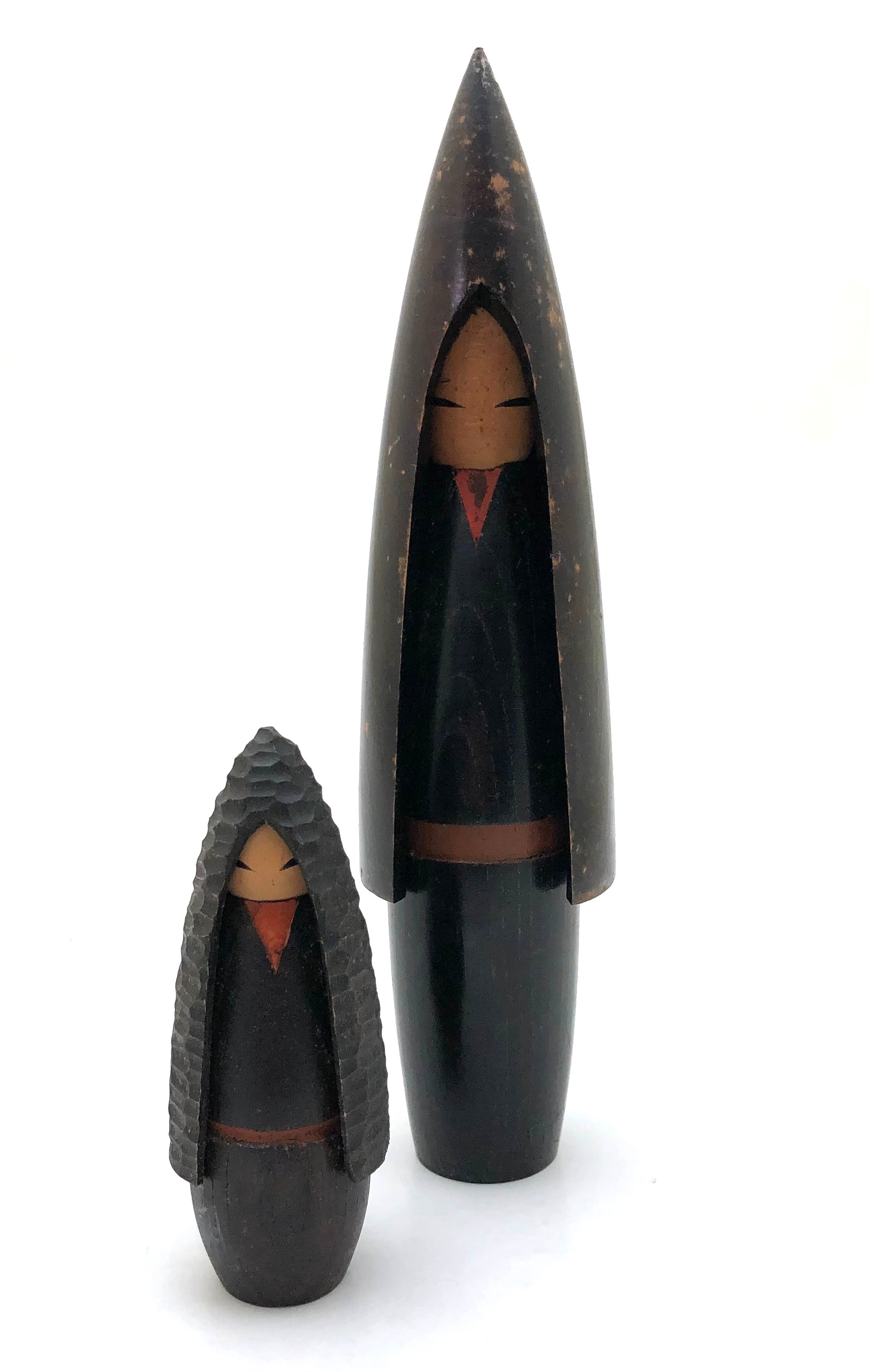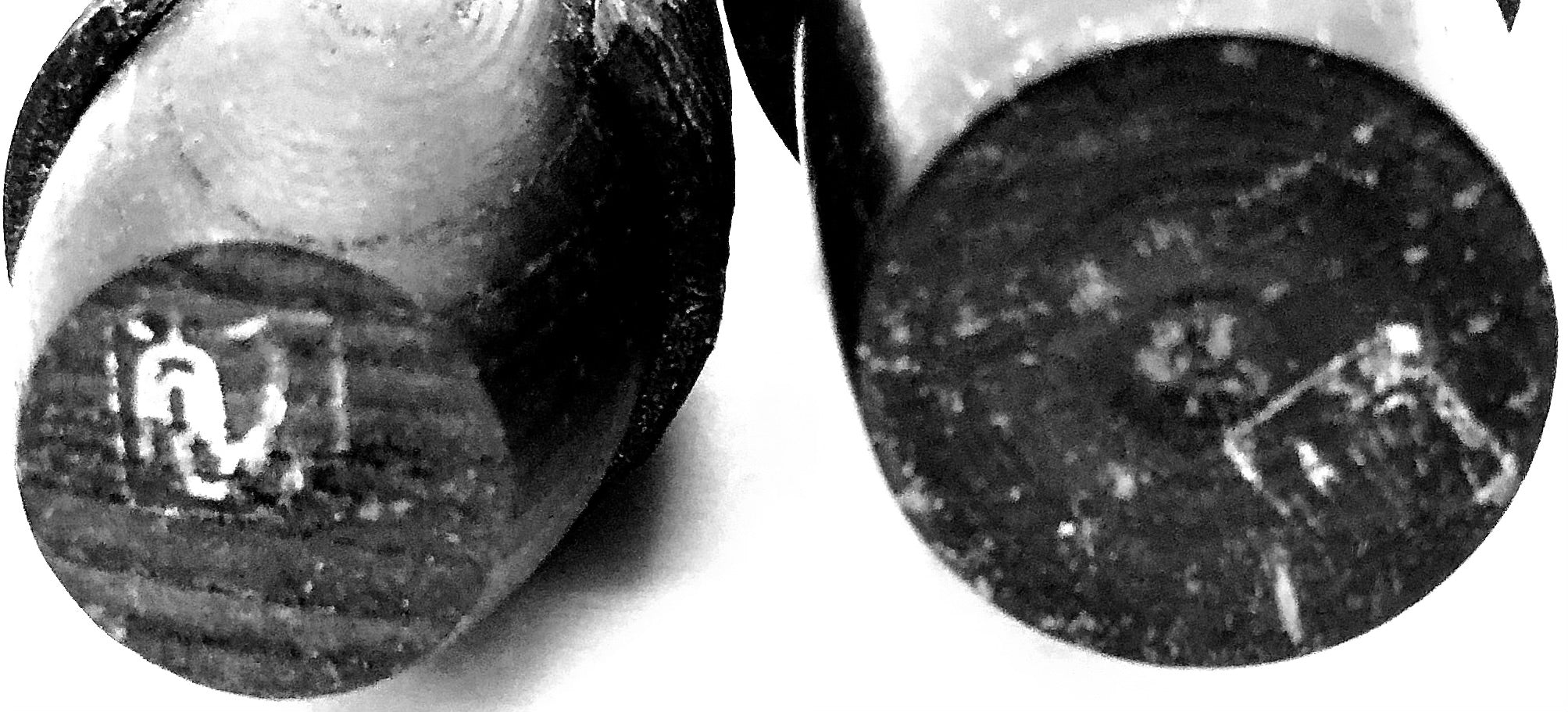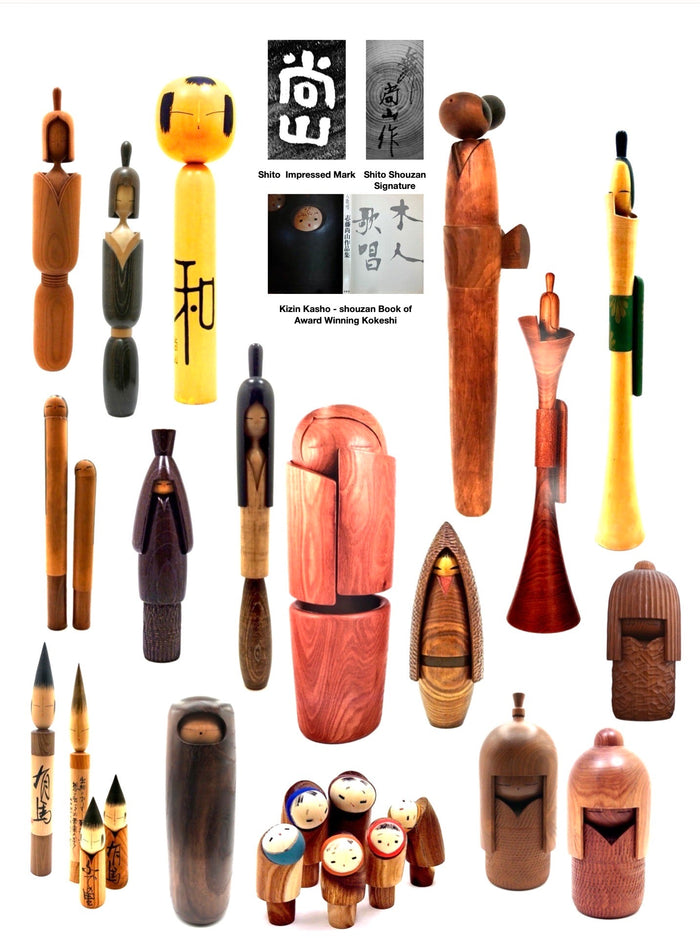

Vintage Sosaku Kokensh entitled: “Fuyu no shojo | Winter Girl” by Shouzan, Shido (1932-1995)
Dimensions: 4-0”h; 9-1/4”h
The northern villagers have traditionally been farmers and silkworm cultivators, who, in spite of bad weather, had to move about without care. These two dolls represent girls wearing a Minomushi, (Snow Coat), which as you have been observing, is a favorite theme of Shouzan-san. The Mino is an article of clothing worn to protect rural people of the mountains from rain and snow, and is fashioned after an earlier version that was made of straw.
Offered is the pair showing diversity in treatment. Firstly is the smallest and the older of the dolls (1950), in which Shouzan demonstrates his love of a textural quality called ‘Chattering’ and demonstrates the process beautifully interpreting these winter coats and places an emphasis on the natural wood. The second, (1970s) and largest of the two shows inspiration from the traditional pitched roofs throughout the Showa Valley region. This treatment was known locally as “Te o inotte”, (praying hands), a reference to the fact that the unique roofs look like praying hands, and were built to shed the heavy snows that fall in the winter. Additionally shown is the use of the pointed Minomushi, (Rain/Snow Coat), in natural patterned and colored woods, (the wood markings on this doll are mineral streaks/spots called ‘pitch pockets’ which is a trail from critters leave a mark. These marks, provide a beautiful contrast in the surface of the wood which the Japanese treasure. Both dolls have expressive faces and red undergarments, along with an obi that is simply a band of waxed/painted wood. Finally a simple face with bangs and slanted eyes are peeping out from under the Mino. Each doll is has Shouzan’s white stamp on the bottom.
Condition: Excellent, original condition, with no fading or loss of color and consistent with age. The piece meets all the standards of collectible Folk Art.

Artisan
Woodworker: Shido, Shouzan
1932-1995
Biographical History:
Shouzan began making Sosaku Kokeshi in 1959, soon after he graduated from Chuo University with a law degree. He is considered by Kokeshi collectors and critics alike to be arguably the most influential artist in the world of Sosaku Kokeshi doll-making. Shido-san’s main focus was depicting unadorned Northern girls in the traditional “Mino”, or Snow Coat, but he also produced tall, thin dolls, which were sparsely decorated. His keen sense of design, minimal use of color, and simple elegant shapes set him apart from his peers, making him one of the most collectible artists emerging from the creative period of the ‘60s winning various awards since 1961. He served as a judge of the All Japan Kokeshi Contest from 1970 to 1976. During that time Shozan published a book entitled Kizin Kasho comprising examples of his award-winning Kokeshi. His dolls have been collected and exhibited worldwide and winner of the Prime Minister’s Award, among many other awards.
Collector's note – descriptive qualities, standard characteristics & ornamentation styles:
Shito-san loved studying the use of combining different types of wood to gain the desired effect and to give dimension to his pieces. He also enjoyed creating slender, tall dolls to support the fact that they resemble the tall, thin trees seen throughout Japan. He incorporated a repetitive textural pattern called ‘Harmonic Chatter work’ to enhance the natural qualities of the wood in many of his works. He particularly enjoyed the textural qualities of ‘Chattering’ on the rain/snow coat, (Minomushi), which is a favorite theme, executed with minimal painted ornamentation, with an emphasis on the natural wood. In general, it is said that Japanese culture is one of modesty and humility. Occasionally saw different types of headdresses, one of which he called a ‘Tsunokakushi’, which is a wide headdress or hood, that covered elaborate hairstyles. We are told that the Japanese people regulate their behavior and response by reading faces and the eyes of others. Here, as well as elsewhere, you will see many examples of different characteristics of the eye's expressions. His most famous doll, which was considered a favorite was called “Mai”, a dancer, which was an elegant and slender doll with a beautifully formed Kimono focusing on traditional hair design (Mage) with an emphasis on a brightly colored “obi” which brings forth the best use of complex geometry to create traditional Japanese clothing elements which were created in 1970.
Shito-san was a prolific artist/woodworker of Kokeshi dolls some of which were whimsical, some focusing on calligraphy citing haiku (poems). We additionally see unusual subjects focused on Zen Buddhism and figures of Daruma, (Bodhidharma) of which most were made in a “roly-poly” type figure seen throughout festivals in Japan.
Explore & Learn More about Woodworker: Shido, Shouzan